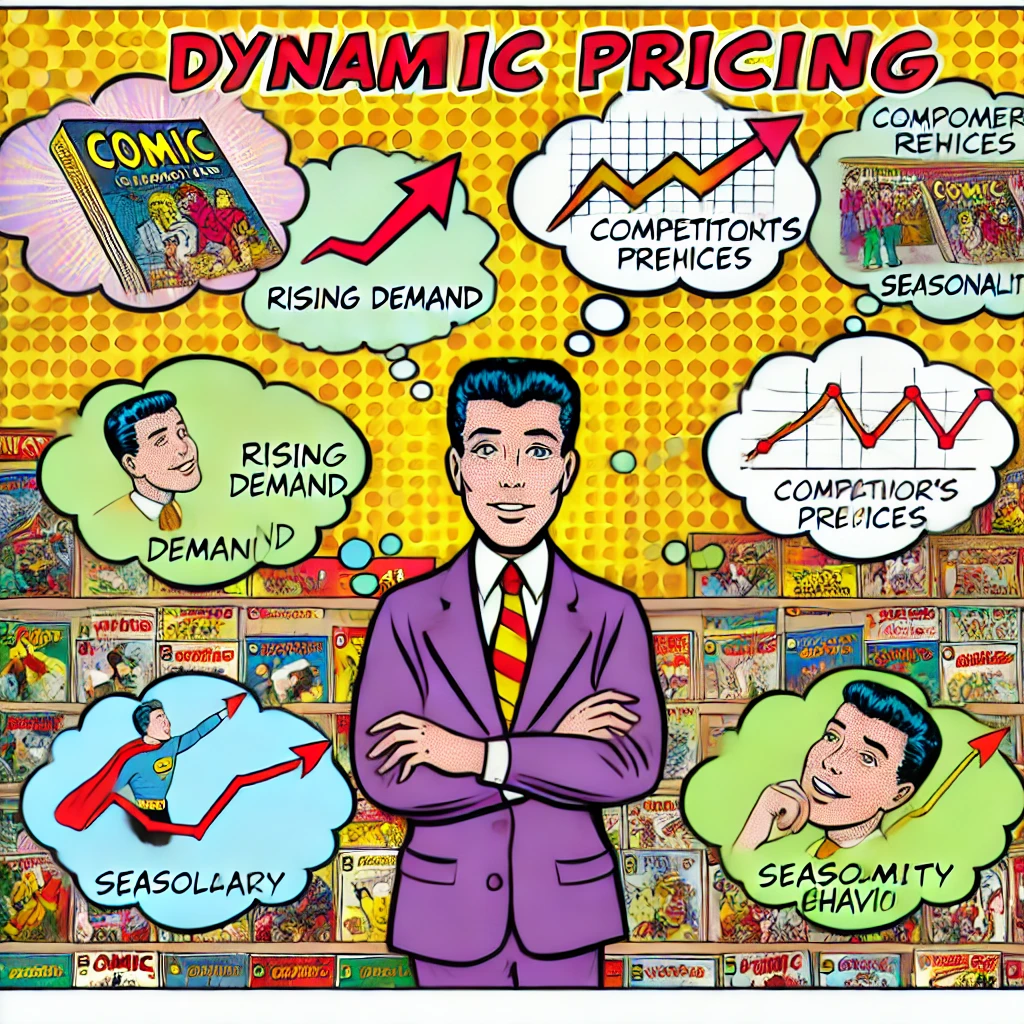
What is dynamic pricing?
Dynamic pricing is a pricing strategy that involves adjusting the prices of products or services in real time based on various factors such as demand, supply, market conditions and customer behaviour. This approach allows businesses to set flexible and variable prices instead of using fixed, static prices.
Dynamic pricing is commonly used in industries such as e-commerce, travel and hospitality, where prices can change frequently. The main goal of dynamic pricing is to maximize sales and profitability by setting higher prices during periods of high demand and lower prices during periods of low demand, ultimately providing customers with fair value for their purchases.

How to use dynamic pricing?
A dynamic pricing strategy allows businesses to optimise prices to maximise sales and profits. Here’s how to use dynamic pricing effectively:
- Data collection: Start by collecting relevant data such as customer behaviour, market demand, competitors’ prices and inventory levels. This data will form the basis for your dynamic pricing strategy.
- Define pricing rules: Create a set of rules and algorithms to determine how prices should change. Consider factors such as time of day, day of the week, customer segment and product availability. For example, you can increase prices during peak times or offer discounts on slower selling products.
- Keep an eye on the competition: Monitor your competitors’ pricing strategies. Dynamic pricing should be responsive to market changes, so being aware of your competitors’ pricing will help you stay competitive.
- Set pricing targets: Clearly define your price targets. Do you want to increase sales, market share or profit margin? Your pricing strategy should be aligned with your business objectives.
- Implement dynamic pricing software: Invest in software or tools that can automate price adjustments based on rules you set. These tools can constantly analyze data and make price changes in real time.
- Test and improveA: Dynamic pricing is not a “set it and forget it” strategy. Monitor results regularly and make adjustments as needed. A/B testing can be a useful method for fine-tuning your pricing strategy.
- Communicate transparentlyA: If your prices change frequently, be transparent with your customers. Inform them about the benefits of dynamic pricing, such as better deals during off-peak times, to build trust and loyalty.
- Comply with regulations and legal aspects: Make sure your dynamic pricing strategy complies with applicable laws and regulations. Avoid practices that could be considered unethical or deceptive.
Advantages of using dynamic pricing
- Maximising salesA: Allows you to adjust prices in real-time based on various factors such as demand, time of day and inventory levels, helping you optimize your pricing strategy to maximize sales.
- Profit margin improvementA: By raising prices during periods of high demand and lowering them during periods of lower demand, businesses can increase profitability without losing customer loyalty.
- Competitive advantageA: Dynamic pricing allows firms to remain competitive by responding to market fluctuations and outperforming competitors.
- Efficient inventory managementA: Helps better manage inventory by lowering prices to sell off excess inventory and raising them to prevent selling out in times of high demand.
- Personalised pricing: Allows you to offer individual discounts or promotions to specific customer segments, increasing customer satisfaction and loyalty.
- Real-time data analysisProvides valuable insights into customer behavior and market trends that can inform future pricing decisions and overall business strategy.
- Increase in salesA: By offering competitive prices during periods of high demand, businesses can attract more customers and increase sales, leading to an increase in overall sales and profitability.
- Adaptation to market changesA: Allows you to adapt quickly to changing market conditions, making it a flexible and agile pricing strategy.
- Increased customer satisfactionA: Properly implemented dynamic pricing can be perceived as fair because it reflects supply and demand, leading to increased customer satisfaction.
Software and tools for dynamic pricing
Dynamic pricing software tools and platforms allow retailers to set specific rules and algorithms that ensure optimal product pricing to attract customers and increase sales. This strategy is a key component of e-commerce, helping businesses adapt to ever-changing market dynamics and gain a competitive advantage.
Conclusion
In today’s dynamic business world, where markets are constantly changing and competition is intensifying, dynamic pricing is becoming an essential tool for the success of any company. This strategy allows companies to optimize their pricing strategies, react quickly to market changes and maximize profits.
Implementing dynamic pricing requires not only technological investment, but also strategic planning and continuous improvement. Businesses that invest in advanced technology and analytical tools gain a significant advantage over their competitors.
If you want to take advantage of dynamic pricing in your business, feel free to contact us at AWDATAPARSING.COM. Pomůžeme vám implementovat efektivní dynamickou cenotvorbu a posunout vaše podnikání na vyšší úroveň.
